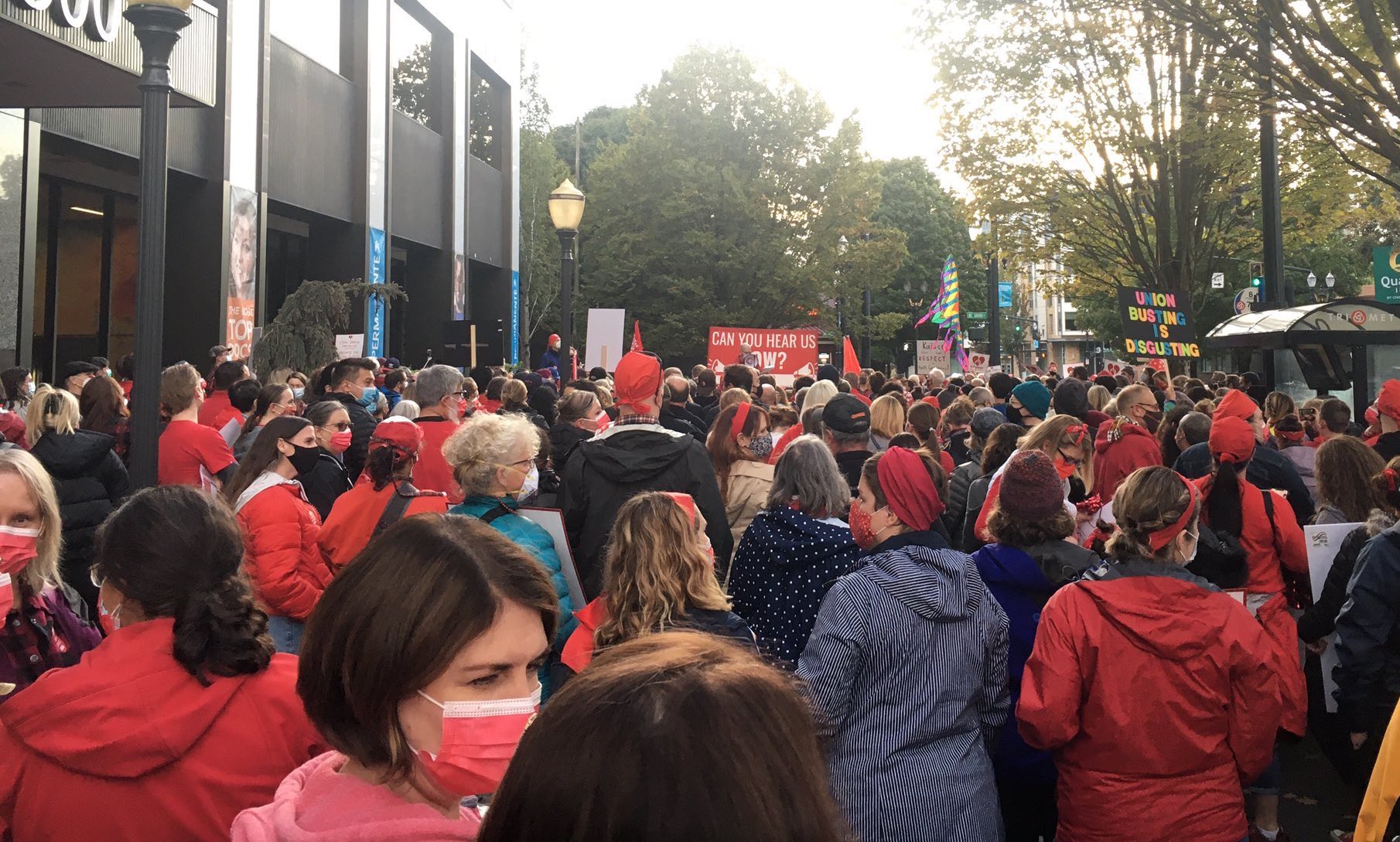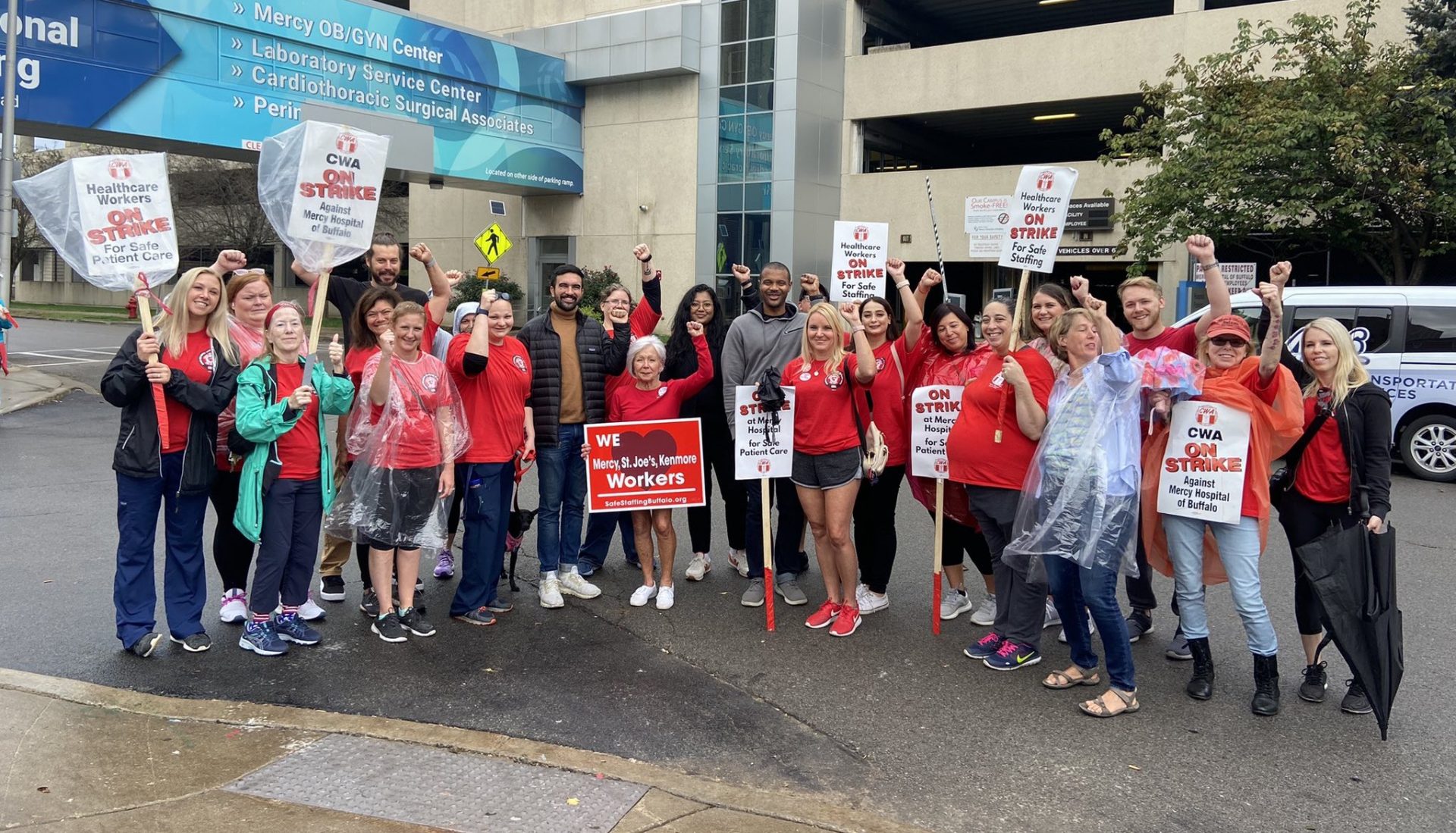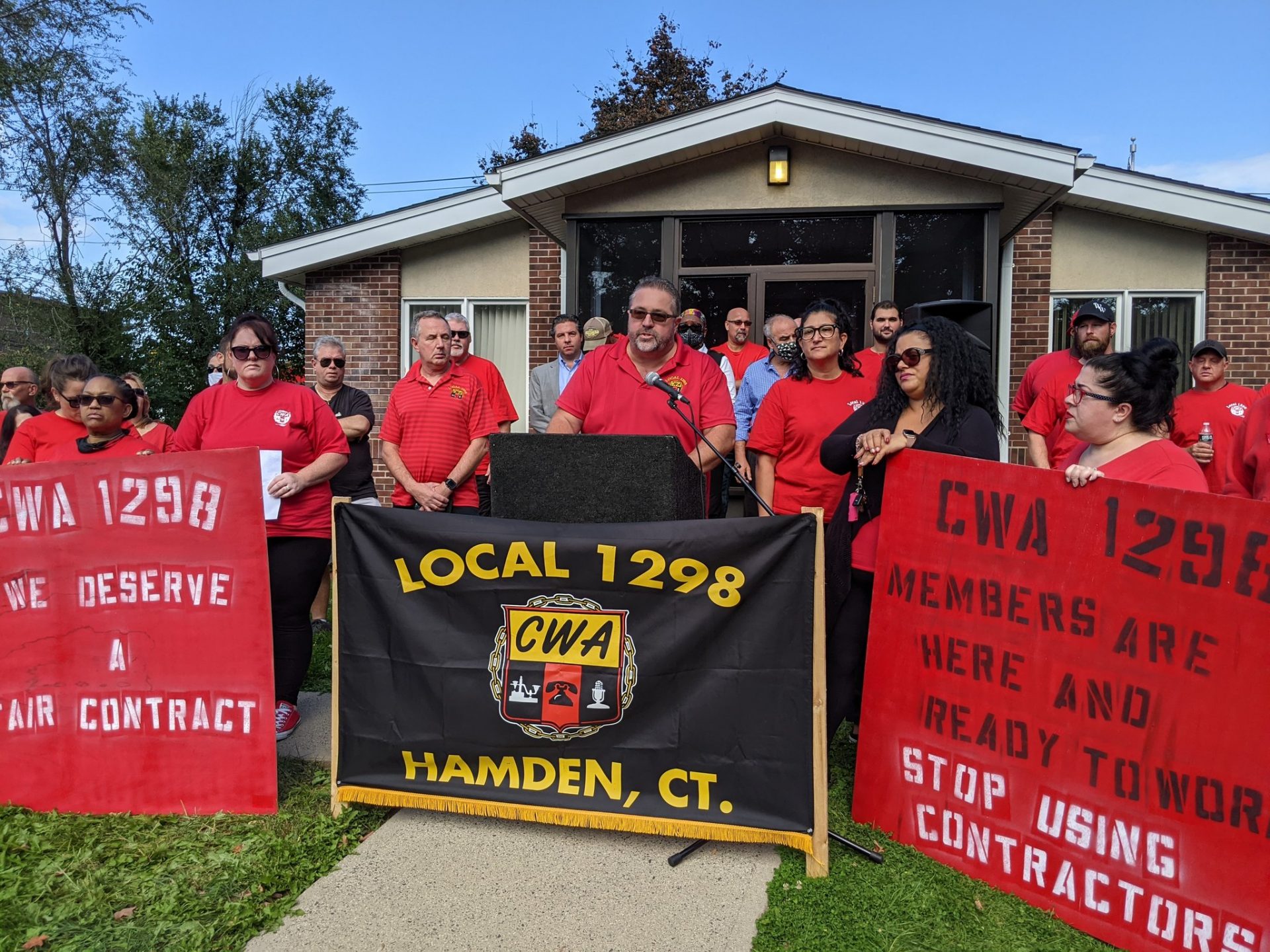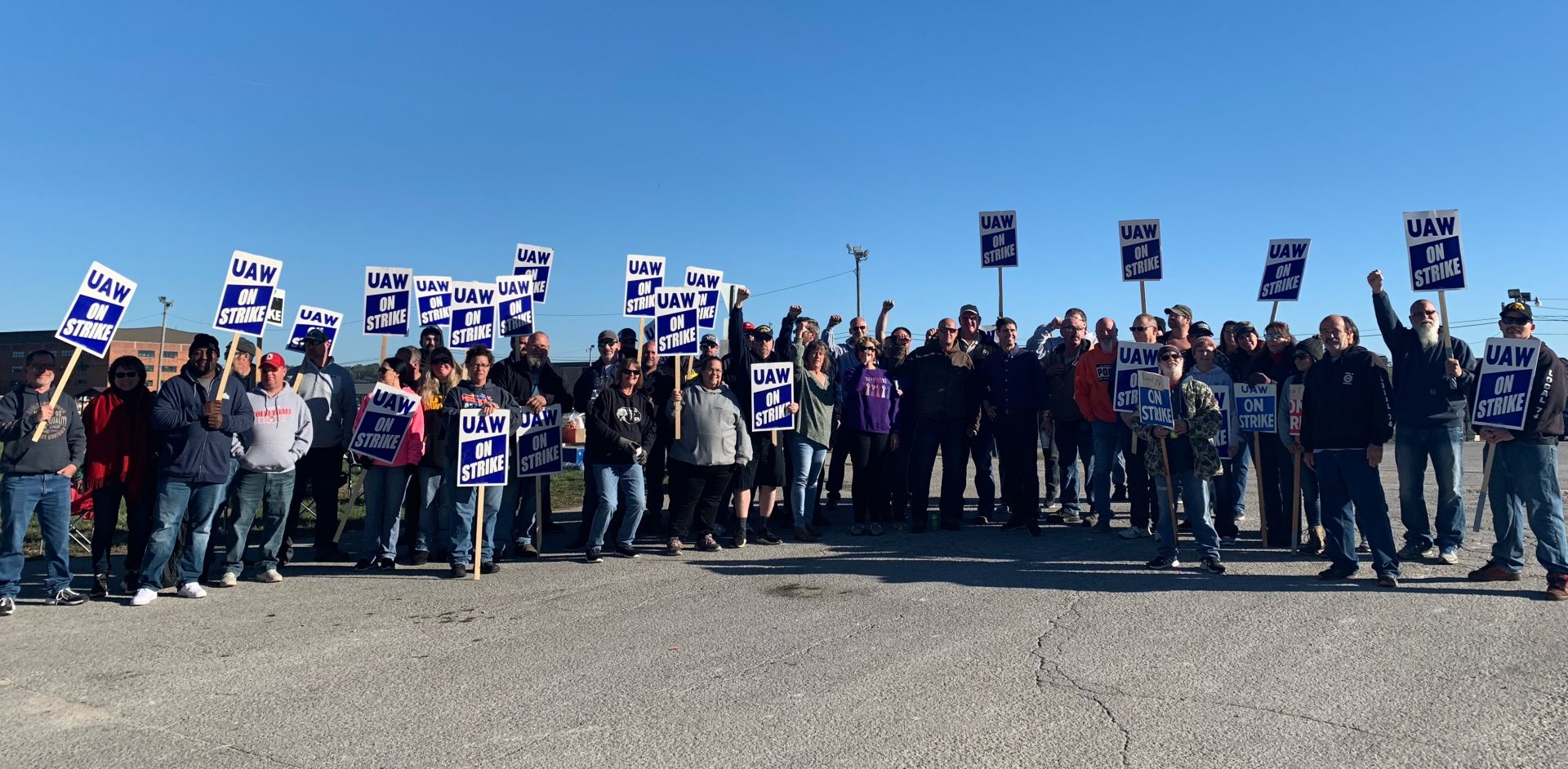
The USA has been hit by a ‘Striketober’ of industrial action across a range of sectors: from healthcare to construction; carpentry to coal mining; media to communications; snack foods and cereal manufacturing. In all, 100,000 workers voted to authorise strike action this month.
The old union bureaucrats have undermined some of these struggles, but they are straining against the rising militancy of a working class that is unwilling to shoulder the economic burden of the pandemic crisis while the bosses’ profits soar.
The profound economic dislocation over the past 18 months is shaking up the system, and setting the stage for a turning point in the American class struggle.
Rising tide
Having risked their lives and made colossal sacrifices, healthcare workers are now demanding their due. 24,000 nurses and other employees at the Kaiser Permanente consortium in California voted to strike this month, alongside further 10,000 Kaiser-employed health workers in Oregon.
This was in response to a new contract that combined a derisory 1 percent pay rise for existing staff, with a cut of between 26 and 39 percent for new hires.
The so-called two-tier system (an increasingly common feature across the US labour market) will allow the bosses to pit sections of the workforce against one another in a general race to the bottom. Meanwhile, Kaiser posted profits of $3bn in the second quarter of 2021.
2,500 nurses and hospital staff employed by the non-profit Catholic Health company also walked out in Buffalo, New York in response to staff shortages, low wages and attacks on pensions. These strikes were in addition to the ongoing nurses strike at St. Vincent Hospital in Worcester, Mass.
The COVID-19 pandemic hit the US particularly hard thanks to the utter incompetence and reckless policies of the establishment.

As a consequence, health workers were placed under massive strain in overflowing wards. “There was no overtime, there was no hazard pay,” said a former health worker in the Guardian, who described 2020 passing in a blur of 24-hour shifts.
These intolerable conditions, combined with 3,600 healthcare worker deaths from COVID-19, have resulted in a critical shortage of staff. This has put even greater pressure on those who remain, especially with the Delta variant leading to a new wave of cases this summer.
“We have people burned out, complaining of mental health issues and PTSD. We’re in a situation as a union where we’re concerned about the future of nursing,” said Denise Duncan, president of United Nurses Associations of California/Union of Health Care Professionals.
Meanwhile, the re-opening of the economy has caused demand to boom in certain sectors; but while the bosses make a killing, workers are pressed even further into poverty and precarity.
For example, John Deere – a manufacturer of farming equipment – expects to rake in a record $6bn of profits this year. This 61 percent increase has seen CEO John C. May reward himself with a $15m dollar annual salary – 220 times that of an average employee.
The latest contract presented to workers on 12 September proposed wages that barely keep up with rising inflation; in addition to increasing healthcare costs, ending a moratorium on plant closures, undermining pension terms for new hires and reducing opportunities for overtime.
Chris Larsen, a United Auto Workers (UAW) activist and John Deere employee of 19 years rightly described this offer as a “slap in the face”, that saw 10,000 workers in Iowa, Illinois and Kansas voting 99 percent in favour of strike action unless a new one was presented.
Following multiple rejected offers, and despite the manoeuvring of the union leadership, a full walkout commenced on 14 October.
Since April, 1,000 Alabama coal miners have been on strike against Warrior Met. The company tried to pass losses incurred by falling demand during the pandemic onto its workers, by drawing up new contracts with inferior pay and conditions.
Now coal prices are soaring again to power heavy industry all over the world, but the bosses are refusing to budge in this especially bitter dispute.
Strikebreakers have intimidated and attacked United Mine Workers of America (UMWA) activists, with multiple instances of vehicles being rammed into their picket lines, putting several activists in hospital.
The miners are nevertheless holding firm. At a protest outside Warrior Met’s offices, UMWA activist Dedrick Garner stated:
“This intimidation, it don’t bother me… What you do today affects what happens to you tomorrow. So if you don’t stand up, you’re gonna fall later.”
1,400 workers at four separate Kellogg’s plants are also striking as of 5 October. A popular lockdown staple, cereal sales increased by more than 8 percent in 2020, with Kellogg’s CEO Steven Cahillane pocketing around $11.6m that year.
Despite this, Kellogg’s announced plans to cut 212 jobs in its Battle Creek, Michigan plant as part of a “streamlining” process, and threatened to outsource even more jobs to Mexico if the Bakery, Confectionery, Tobacco Workers and Grain Millers International Union (BCTGM) responded with strike action.
Additionally, Kellogg’s bosses are removing cost of living provisions and attacking holiday pay and vacations, while introducing a two-tier pay and benefits system for current and new employees. All the while, the company squeezes workers for every drop of profit.
“One year ago, we were hailed as heroes, as we worked through the pandemic, seven days a week, 16 hours a day. Now apparently, we are no longer heroes. Very quickly you can go from hero to zero,” said Trevor Bidelman, president of BCTGM Local3G employed at the Kellogg’s plant in Battle Creek.
He continued:
“We don’t have weekends, really. We just work seven days a week, sometimes 100 to 130 days in a row. For 28 days the machines run then rest three days for cleaning. They don’t even treat us as well as they do their machinery.”
The hypocritical celebration of ‘key workers’ by the capitalist establishment during the pandemic, followed by these renewed attacks, have contributed to a change in consciousness among American workers; especially with talk of economic ‘recovery’, albeit a fragile one.
This in turn is leading to an increased willingness to fight back.
To the above examples, we can add communications workers in California; transit workers in Texas; public works employees in Minnesota; dining workers in Illinois; group home workers in Connecticut; graduate workers at Harvard and Columbia University and bakery plant workers in Portland.
All have authorised strikes in recent weeks. These outbursts of labour unrest signal a subterranean layer of working-class resentment, built up following decades of cuts and betrayals, finally seeping through the cracks opened up by the impact of COVID-19.
Strikes undermined
The union leadership are attempting to reign in the growing assertiveness of the working class, and have sold out a number of major battles.
The pandemic propelled the profits of companies like Netflix, Hulu, Disney and Amazon to dizzying levels, as their streaming services provided the bulk of media entertainment to audiences stuck at home due to lockdowns.
So-called ‘new media’ productions boast budgets comparable to major film releases, $465m in the case of Amazon Prime’s new Lord of the Rings series.
But companies like Amazon successfully lobbied the US government for the right to hire workers on the cheap, and with fewer protections, as compared to ‘traditional’ film and television crews.
On top of this, even though lunch provisions for Hollywood workers (which have not been updated since the 1980s) stipulate an hour’s break every six hours, big companies can simply swallow a “meal penalty” and insist a shoot carry on indefinitely.
One production crew member interviewed for the worker advocacy group, More Perfect Union, said:
“I did a show this year that was $12m an episode, for a company (Amazon) whose CEO just went to space, and we were scheduled for 16-hour days and no lunch breaks, for a six-month show.”
Workers describe falling asleep on set. Passing out from hunger. A Hollywood worker recently had a fatal car accident due to fatigue: the fatal cost of lining Jeff Bezos’ pockets.
But despite near unanimous support among grassroots activists for the strike, it was called off at the last minute on 18 October following an agreement between IATSE negotiators and the media barons.
The settlement includes a retroactive wage increase of 3 percent – despite annual inflation index edging up to over 5 percent in July 2021. The deal apparently stipulates a 10-hour daily turnaround time, though this is still a punishing working day compared to many other sectors.
And despite introducing higher penalties for companies that don’t provide adequate meal breaks, companies like Disney and Amazon consider these fines part of ‘the cost of doing business’ on long shoots.
The arrangement also covers only 40,000 film and TV industry workers, leaving tens of thousands out of the loop.
These ‘concessions’ are peanuts compared to what could’ve been won by the planned mobilisation of IATSE’s members, and will surely permit the Hollywood fat cats to breathe a sigh of relief.
Meanwhile, 2,000 workers organised by the Northwest Carpenters Union launched a strike in September.
These workers complained that wages have not kept up with the cost of living, while $200m has been lost out of their pension funds – coincident with the biggest construction boom in the history of the Seattle and Western Washington State area in 2020/21.
On multiple occasions, the union bureaucrats attempted to end the strike prematurely, negotiating derisory deals with the bosses, and deliberately undermining strike action. This caused outrage amongst the rank-and-file workers.
Art Francisco, chair of a radical rank-and-file Peter J. McGuire Group, claimed the union leaders selected empty construction sites as picket sites, and refused to allow a picket at Microsoft’s Westside Redmond campus: whose redevelopment represents the biggest construction job on the West Coast.
This apparently led to a “crazy screaming match between mainly the [union members working on the Microsoft project] and the leadership” at a strike rally, which nearly spilled over into a “physical fight”, until the leadership eventually agreed to a picket at Redmond.
But despite this pressure from below, the three-week strike ended in a narrow vote for the latest bosses’ offer of a $10.02 per hour increase to wages and benefits over three years, after workers voted down the previous proposed contract settlements.
While a noteworthy concession, this fell well short of the expectations of thousands of union activists.

As Francisco correctly pointed out in a recent interview, the US union bureaucracy has increasingly treated the mass organisations “as a labor broker, not as a union.”
The leadership sees its role as conducting respectable, closed-room discussions with the bosses for ‘mutually acceptable’ concessions. They have ditched the class struggle for “labour-management partnership”.
Since the historic defeat of the PATCO airline strike in the 1980s by the Reagan administration, – which was a massive blow to the confidence of the grassroots labour movement – the union leaders increasingly served as a yoke on the organised working class: maintaining them within safe channels for capitalism.
This process was deepened by the organic crisis of capitalism in 2008, after the labour leaders held back the working class from opposing cuts and austerity.
The union bureaucracy has been rewarded for its service to the ruling class. In the past several months, a layer of UAW leaders have been found guilty of embezzlement and taking bribes from Fiat Chrysler: one of the biggest employers in the industry.
However, the mighty 2018 Virgina Teachers’ strike where tens of thousands of rank-and-file educators, in defiance of their trade union tops, engaged in radical strike action.
This was a turning point and inspiration to workers across the USA. It was followed by an uptick in industrial activity, including a major strike at General Motors in 2019.
The pandemic cut across this trend for a time, but the US labour movement is now beginning to retie the knot of history.
Grassroots clashing with bureaucracy
The impact of the pandemic crisis has increasingly brought the rank-and-file workers into conflict, not only with the bosses, but also with their class-collaborationist leadership.
UAW leaders repeatedly attempted to prevent the John Deere strike by securing lousy deals with the bosses. This was met with furious opposition by grassroots activists.
At a meeting of the Waterloo, Iowa, UAW Local 838, members printed their concise response to their union’s latest negotiated offer on their t-shirts: “Fuck No.” One member allegedly took the microphone and said the deal was only fit for “wiping my ass.”
Later, the union leaders attempted to head off the strike at the eleventh hour by way of a Facebook post, at midnight of the old contract expiration (1 October), declaring an extension to negotiations, and members should “report to work tomorrow”.
This was an obvious attempt to derail the strike, which had to be repelled by grassroots pressure.
One member let their feelings known in a comment on the original post: “What happened to all the ‘Will strike if provoked’ BS? What is the union’s definition of provoked?? Can we get shirts saying ‘Will back down if threatened?’”
This clash between the leadership and grassroots comes off the back of years of deals between UAW and the big automotive employers, which have seen wages and conditions screwed further and further down, especially for the new hires.
Sick of the behaviour of their union tops, grassroots members – organised in the Unite All Workers for Democracy (UAWD) caucus – are now pushing for a direct, one member-one vote system for elections to the union’s leading bodies.
However, if such a system is implemented, in the context of a national union election, campaign money and the ability to travel still gives the incumbents the edge. There are no shortcuts to taking back control of the union, the membership must organise everywhere.

The Teamsters, who adopted one member, one vote in the 1990s, are also seeing a struggle between insurgent new layers and the old bureaucracy – represented respectively in the Teamster United and Teamster Power slates for the union’s presidential election.
The slate led by Sean O’Brien, leader of Teamster United (or ‘OZ’) appears to have the edge with members so far.
O’Brien has been buoyed by members’ fury at current president James Hoffa, who oversaw a deal that allowed the creation of a lower tier of casualised, ‘Uberised’ delivery drivers in negotiations with UPS.
Hoffa has also consistently refused to lead Teamster workers in industrial action, favouring backroom deals with the bosses.
As OZ organizer Ken Paff states: “we want a union that isn’t telling members what can’t be done. We want one that says, ‘When members want to fight, we’ll be there with them shoulder to shoulder.’”
A victory for ‘OZ’ would certainly be a step forward for the American working class. There is clearly an appetite for a fight emerging from the ranks of the US labour movement, and we are beginning to see more radical layers pushed to the fore to challenge the dominance of the old bureaucracy.
These new leaders will be put to the test in the next period. In the end, their success will depend on whether they are willing, not only to challenge the individual employers, but, the capitalist system itself.
Changing consciousness
During the pandemic, millions of workers were called on to make huge sacrifices “for the national interest” – united against the common enemy of the pandemic. Many were faced with the choice of risking their health at work, or scraping by with government handouts.
Terrible losses were inflicted, including a higher number of deaths than Americans faced during the Spanish influenza. A huge amount of fury has built up against the rotten, greedy capitalists and their political cronies, who oversaw this catastrophe.
Now, however, the pandemic appears to be waning, profits are soaring and yet, in many places there is no respite from the pressures put on workers during what were supposed to be exceptional circumstances.
On top of this, living conditions are constantly being undermined by rising inflation. In fact, real-term wages are still below pre-pandemic levels, and have steadily declined in the past year.
Therefore, while the newspapers talk about a recovery, working families are not feeling it in their pockets. Coupled with the shameless and highly visible wealth of the richest in society, who in the US have added $1.8tn to their fortunes during the pandemic, an increasing number of Americans have decided that enough is enough.
All of this is spurring many layers of the working class onto the scene of struggle, to fight to maintain their conditions, and to demand back what is owed to them.
Their confidence is boosted by the fact that the economic boom has led to generalised labour shortages, which we have commented on elsewhere. For the first time in a generation, workers are starting to feel like they are the ones with the leverage, rather than the bosses.
We should not overstate these developments. Union representation in the USA remains historically low (although it did climb for the first time in 2021, albeit only slightly); and these strikes are only the dress rehearsal for far-bigger clashes to come.
The Democrats – who have historically worked hand-in-glove with the union bureaucracy to hold the workers back from open struggle – desperately want to get out ahead of and co-opt this radical energy.
Seeing the writing on the wall, Joe Biden has proposed the Protecting the Right to Organize Act (or PRO) Act. This would increase workers’ capacity to organise and weaken the union-busting “right-to-work” laws that exist in 27 states. Biden knows this is unlikely to pass the US Senate.
But even if it does, it is far from what is needed because it does not repeal existing anti-union legislation like Taft-Hartley. In reality, the primary purpose of this law is to try to channel the rising working class militancy down a safe path where it is safely under the control of the existing bureaucracy, the Democrats, the National Labor Relations Board and legal channels.
What the US working class needs are serious fighting organisations and leaders. This would allow the workers to exercise their independent power, generalise these various struggles, and fight for major conquests like a $1,000-a-week minimum wage tied to inflation, high-quality universal healthcare and – most importantly – a political party of their own.
There is ample appetite for this, both within the mass organisations and wider society. In a September 2020 Gallup Poll, 65 percent of respondents (and 77 percent of under-34s) said they approve of unions, tying with 2003 and 1999 as the highest level of public support in the last 53 years.
On top of this, while the bulk of the workforce is under the age of 34, this represents only a fraction of the unionised workforce. As living conditions come under increased pressure, more and more of this layer will be thrust into struggle. Many of these young radical workers will see the mass organisations as a means to fight for their interests.
Once in the unions, they will add their opposition to the craven, capitulating labour leaders, and battle to transform the unions from top to bottom into genuine instruments of class struggle.
Taken together, we are glimpsing a new beginning in the history of the US labour movement.

